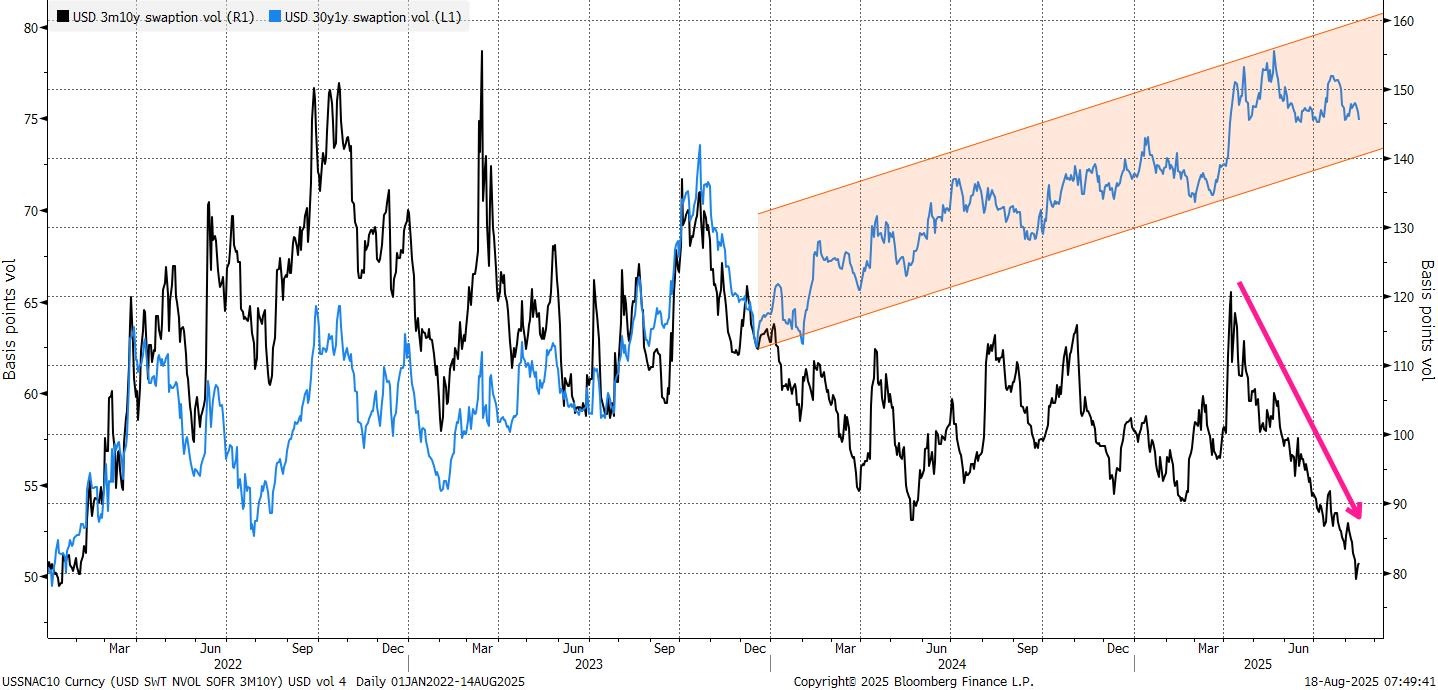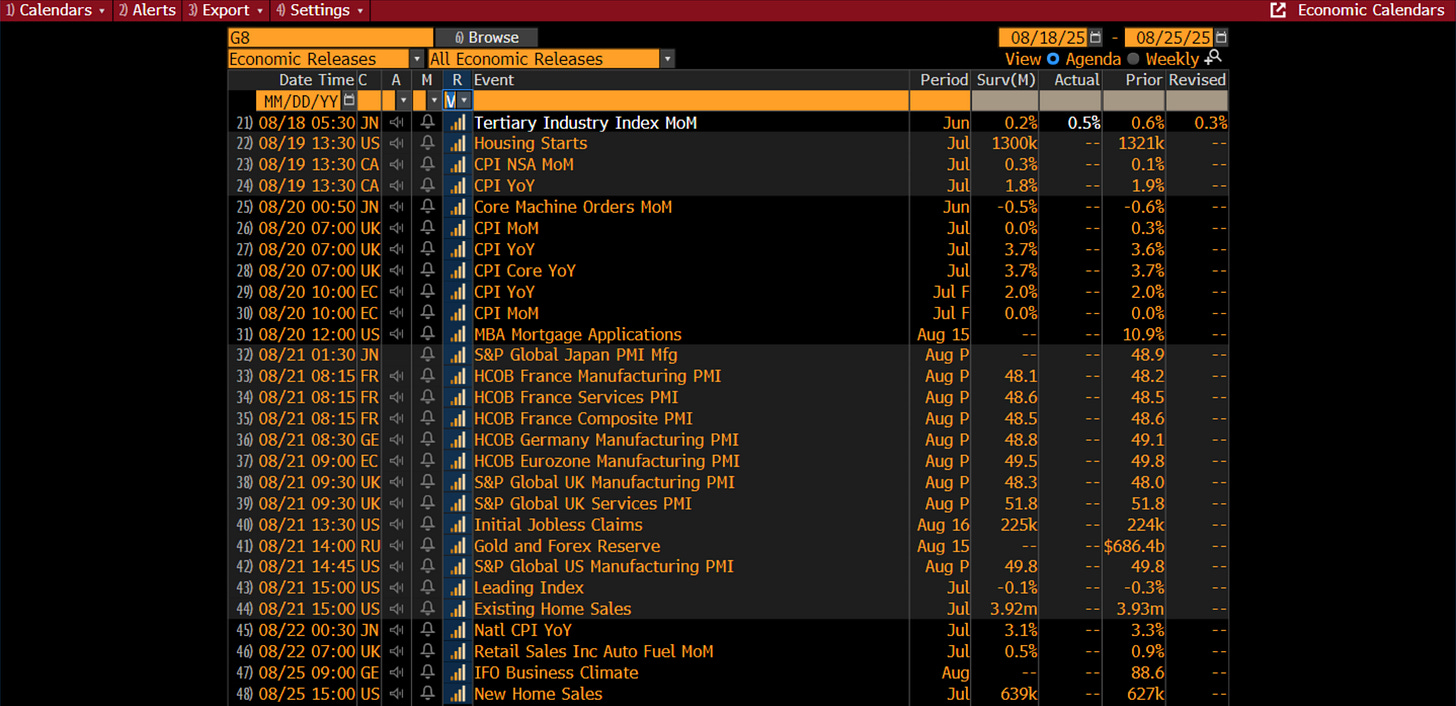Equities Rise Into Powell Test
A weekly look at what matters and how to trade it. (August 18th)
US equities ended the week higher in a subdued, low-volatility environment, with the main catalyst coming from softer-than-expected CPI data. Health care led the advance, thanks in large part to a rebound in UnitedHealth Group after Warren Buffett and David Tepper disclosed positions in the stock. Media names also stood out, with the newly created Paramount Skydance surging 48% across two sessions, sparking memories of the meme-stock frenzy in 2021. With earnings season fading into the background, markets were left trading on macro signals. The much-hyped Trump–Putin summit in Alaska passed without fireworks, offering little more than photo ops. Focus now shifts to Trump’s upcoming meeting with Zelenskyy. The last time the two met, tensions spilt into markets, triggering a dollar slide. Investors will be watching closely to see if history rhymes.
The S&P 500 rose 0.9% for the week, the Dow Jones gained 1.7%, and the Nasdaq 100 edged 0.4% higher. Looking ahead, the spotlight shifts to retailers, with Walmart on Thursday the main event. Home Depot, Lowe’s, and Target will also report, offering a timely read on how tariffs and consumer sentiment are shaping the retail landscape.
Corporate headlines added to the week’s narrative. Intel surged 23% after reports surfaced that the Trump administration is considering a government stake in the company, potentially financed by the Chips Act. Trump, who previously called for CEO Lip-Bu Tan’s resignation, struck a conciliatory tone following a meeting, praising Tan’s leadership.
On the macro side, economic data dominated. July CPI rose 2.7% year-on-year, just below estimates, driving much of the equity rally early in the week. PPI, however, came in hotter than expected at 3.3% year-on-year versus 2.5% forecast, which tempered the momentum. Still, markets absorbed the release without derailing the broader move higher. Fed commentary was muted, with attention fixed instead on the White House’s search for Powell’s successor. Names such as Stephen Miran and Marc Sumerlin were floated, both of whom gave dovish remarks in line with Trump’s policy preferences.
In other assets, FX markets tracked the data, with the dollar weakening after CPI but regaining ground following the stronger PPI. Treasury yields mirrored the same pattern, ending the week slightly higher, with the 10-year yield up about 4bps. The curve steepened, led by the long end, with the 5s30s wider by 6.5bps into the weekend. While US data drove the front end, the steepening impulse was more influenced by European rates. Volatility at the short end remains historically low, marking one of the quietest stretches in three years.
To access full articles and research, manage your account here.
The Economic Week Ahead
The coming week is dominated by the Federal Reserve, with both the minutes from July’s meeting (Wednesday) and Chair Jerome Powell’s keynote at Jackson Hole (Friday) expected to set the tone for September’s policy decision. Markets have shifted decisively toward expecting a 25bp cut next month after weak employment data and tame July inflation, with futures now pricing the move at over 84.8% probability. Investors will parse Powell’s speech for any indication of whether the Fed might consider going larger, as some in Washington have urged. The symposium theme, “Labor Markets in Transition,” ensures that wage growth, productivity, and the jobs outlook will be in sharp focus, a timely theme after the recent weaker-than-expected jobs reports.
The US data flow is secondary but still meaningful. Tuesday’s housing starts will give a read on residential momentum, while Thursday’s flash PMIs for manufacturing and services will offer the first real-time signal on how the new tariffs are affecting activity and prices. Weekly jobless claims on the same day remain critical in tracking labour market deterioration. Treasury supply is also in view, with a 20-year bond auction on Wednesday and 30-year TIPS on Thursday.
In Europe, the UK releases July inflation data on Wednesday, the key test for whether the BoE can sustain its easing cycle. June’s overshoot forced markets to scale back expectations for further cuts, and another upside surprise could derail November cut pricing. Thursday brings preliminary PMIs across Europe, the UK, and the euro area, the first clean look at tariff effects on activity. Eurozone flash consumer confidence is due the same day, followed on Friday by Germany’s detailed Q2 GDP release and France’s business sentiment survey. In Sweden, the Riksbank decides policy on Wednesday and is expected to hold rates steady at 2%, though policymakers remain open to cuts if the growth shock from tariffs deepens.
In Asia, Japan is the focus with the July CPI due Friday. Core inflation is expected to remain well above the BoJ’s 2% target, reinforcing speculation that the bank could move earlier on rates. Trade data on Wednesday should confirm the drag from US tariffs, particularly in autos. Elsewhere in the region, central banks are active: China’s loan prime rate decision (Wednesday) is expected to keep policy steady, while New Zealand’s RBNZ is forecast to cut 25bp, extending its easing cycle as growth and employment remain weak. Bank Indonesia is likely to stay on hold, monitoring rupiah stability after July’s cut.
The most consequential emerging-market prints come from Canada and China. Canada’s July CPI (Tuesday) is pivotal for the BoC’s September call, especially after soft jobs data. In Asia, China’s PBoC rate decision (Wednesday) is widely expected to leave lending benchmarks unchanged, with targeted credit support still the preferred easing channel.
Beyond that, EM releases are less market-moving but still notable. In New Zealand, the RBNZ’s monetary policy decision will dominate.
Moving on to our market thoughts and ideas for the week ahead.
Volatility
Protecting Against the Complacency Trade:
Equities have marched to fresh highs, the S&P 500 closing last week with the VIX down at 14.3, its lowest since Christmas Eve 2024. Implied volatility has slipped below realised on the 10-day horizon, telling us that downside protection is being heavily discounted. That’s usually the time to think about hedges.
Protection is cheap, positioning is light, and with vol sellers in control, the risk is getting caught flat-footed into the Autumn calendar. We’re not looking to overweight the hedge book, but a small percentage allocation makes sense, buying insurance when it’s affordable, not when it’s needed.
Last week, we highlighted three clean ways to express the view:
Long Sept VIX Futures (UXU5): the simplest structure, offering linear exposure to a vol rebound with clear stop-loss and take-profit levels.
Oct VIX Call Spread (UXV5 22/24): defined risk, asymmetric payout (8:1 max), and longer runway into expiry.
Sept–Dec VIX Spread (UXU5 vs UXZ5): reduces carry drag from contango and isolates a near-term vol spike.
Each of these approaches balances cost with convexity. Whether via outright futures, defined-risk options, or curve spreads, the objective is the same: layer in portfolio protection while the market is relaxed.
The message is straightforward: hedges are best bought when nobody wants them.
For more on volatility, make sure you have read through our latest primer:
Commodities
Oil, Contango Risk Into Year-End:
The updated balance sheets point to a clear surplus: nearly +900k b/d on average through mid-2026, translating into 100mn barrels of inventory builds. Brent has already slipped from last year’s $80 average to the low $70s, and with OPEC+ supply picking up just as Chinese storage capacity runs tight, the path to sub-$60 Brent in 2H25 looks credible.
In the near term, the forward curve should reflect this dynamic, a flip into contango as inventories build. That sets up a tactical bear case for prompt Brent. At the same time, longer-dated contracts remain anchored in the $60–$80 range with recovery potential into 2H26 once easier policy, weaker USD, and lower US volumes kick in.







